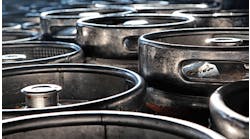By Dan Heber, PE, Senior Technical EditorPROCESS PLANTS need backup power to ride through short term utility power disturbances and to ride through from utility to generator power. According to flywheel power system manufacturer Pentadyne, 99.5% of power disturbances are only a few cycles to a few seconds in duration. Although these disturbances are brief, it is imperative to provide backup power, so that solid-state control and monitoring systems can continue to operate. Without backup power, these solid-state systems will shut down and cause plant downtime at best, and lost product and damaged equipment at worst.Most plants get their primary power from their local utility grid, and backup power is provided by an uninterruptible power source (UPS) fueled by batteries. UPSs usually provide the relatively small amounts of backup power needed for the control systems.Flywheel technology, originally developed for hybrid electric vehicle applications, recently has been commercialized as a viable substitute to batteries for supplying power to UPSs. Basic operation is simple and intuitive. When a user needs power, a flywheel converts its kinetic spinning energy into electricity. A flywheel can deliver its stored energy fast—much faster than a battery can—and flywheel systems have a virtually unlimited cycle life.A small amount of power is provided to spin the flywheel. Power can be drawn from the flywheel as needed when power disturbances or outages occur. A flywheel can supply a small amount of power for a relatively long period of time, or a larger amount of power for a shorter duration. For example, Pentadyne’s standard flywheel energy storage systems can support a 225 kVA load for 13 seconds or a 32.5 kVA load for 89 seconds. As many of these standard systems as desired can be paralleled together for higher power, longer run-time, or redundancy. For example, five systems can be paralleled to support a 1,000 kVA load for 16 seconds.Flywheel energy systems can be classified in two categories: low speed and high speed. Traditional, low-speed flywheels are made of steel and rotate at relatively low speeds of less than 10,000 rpm. Low speed flywheels have certain advantages, such as relatively simple design. Disadvantages include low power density, multiple bearing requirements, and substantial energy loss during idling due to high aerodynamic and mechanical bearing drag.High-speed flywheels use high-strength composite materials and magnetic bearings, which allow them to spin at much greater speeds, and generate far greater power density as the stored energy in a flywheel is proportional to the square of its rotational speed. Although high-speed flywheels can rotate up to 100,000 rpm, most operate in the 25,000 to 60,000 rpm range. High-speed flywheels offer a number of distinct advantages over low speed flywheels including high power density, compact design, high efficiency, low maintenance, and minimal aerodynamic drag.Modern high-speed flywheels employ a host of advanced technologies to increase efficiency and reduce maintenance.Pentadyne’s systems use a high-speed flywheel (stress-tested to 73,000 rpm) comprised of a multi-layer carbon-fiber composite cylinder with a titanium hub attached to a nickel alloy shaft. Three sets of magnetic bearings (five-axis control) levitate the entire rotating assembly and allow high rotational speeds to be realized with minimal friction and maintenance. Two touch down shafts act as support during transit and non-operation. An integrated vacuum pump continuously provides pressures 1 million times lower than atmospheric pressure, virtually eliminating aerodynamic drag. The flywheel’s mechanical energy is converted to electrical power through a synchronous reluctance motor. To control the flow of electrical energy, the flywheel power controller uses high-power insulated gate bipolar transistors and pulse width modulation to either extract or supply energy. It also uses a digital signal processor (DSP) to provide control with all other parts of the control system, and acts as a master controller for the magnetic bearing controller and the user interface port.Batteries share many of the same power provision characteristics as flywheels but present a host of operational and maintenance problems not shared by flywheel-based systems. According to a white paper authored by Caterpillar, lead-acid batteries have proven unreliable and expensive in UPS applications for a variety of reasons. Although batteries are typically warranted for 20 years pro rata, they actually must be replaced every four to five years because they wear out much more quickly with repeated use. Battery leaks and spills are common, creating a safety hazard and potential damage to the environment. Flywheel UPSs have a useful service life in excess of 20 years with minimal maintenance. Maintenance of the Caterpillar UPS consists of changing bearings once every two to three years. The Pentadyne UPS uses active magnetic bearings that require little or no maintenance.

Leaders relevant to this article:


